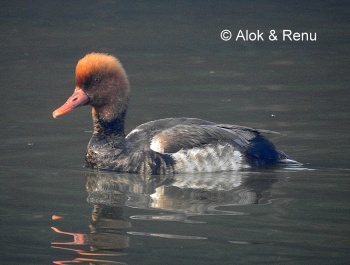- Netta rufina
Identification
53–58 cm (20¾-22¾ in)
Male
- Rounded orange head
- Red bill
- Black breast
- White flanks
- Brown back
- Black tail
Female
- Pale brown
- Darker back and crown
- Whitish face
Distribution

Photo © by Alok Tewari
Sultanpur National Park, Gurgaon, Haryana, India, December-2017
Locally in Southern Europe from the Mediterranean basin to southern and central Asia.
Northern populations may move south into north Africa for the winter.
A popular species in wildfowl collections, so escapes can appear anywhere.
Taxonomy
This is a monotypic species[1].
Habitat
Their breeding habitat is lowland marshes and lakes; their preference is for deep water, both fresh and brackish.
Behaviour
Diet
A diving duck, though they also 'dabble' for their food, which is mainly aquatic plants, roots, seeds and will also forage on potatoes.
Breeding
They nest beside freshwater lakes laying 8-12 pale green eggs.
Vocalisation
References
- Clements, J. F., T. S. Schulenberg, M. J. Iliff, D. Roberson, T. A. Fredericks, B. L. Sullivan, and C. L. Wood. 2017. The eBird/Clements checklist of birds of the world: v2017, with updates to August 2017. Downloaded from http://www.birds.cornell.edu/clementschecklist/download/
- Handbook of the Birds of the World Alive (retrieved November 2016)
- Wikipedia
Recommended Citation
- BirdForum Opus contributors. (2025) Red-crested Pochard. In: BirdForum, the forum for wild birds and birding. Retrieved 1 May 2025 from https://www.birdforum.net/opus/Red-crested_Pochard
External Links
GSearch checked for 2020 platform.1






